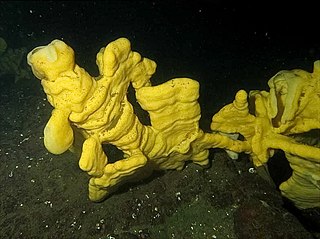Related Research Articles

Sponges, the members of the phylum Porifera, are a basal animal clade as a sister of the Diploblasts. They are multicellular organisms that have bodies full of pores and channels allowing water to circulate through them, consisting of jelly-like mesohyl sandwiched between two thin layers of cells.

Streptomyces griseus is a species of bacteria in the genus Streptomyces commonly found in soil. A few strains have been also reported from deep-sea sediments. It is a Gram-positive bacterium with high GC content. Along with most other streptomycetes, S. griseus strains are well known producers of antibiotics and other such commercially significant secondary metabolites. These strains are known to be producers of 32 different structural types of bioactive compounds. Streptomycin, the first antibiotic ever reported from a bacterium, comes from strains of S. griseus. Recently, the whole genome sequence of one of its strains had been completed.
Actinoalloteichus is a genus in the phylum Actinomycetota (Bacteria).
Streptomyces isolates have yielded the majority of human, animal, and agricultural antibiotics, as well as a number of fundamental chemotherapy medicines. Streptomyces is the largest antibiotic-producing genus of Actinomycetota, producing chemotherapy, antibacterial, antifungal, antiparasitic drugs, and immunosuppressants. Streptomyces isolates are typically initiated with the aerial hyphal formation from the mycelium.
Streptomyces axinellae is a bacterium species from the genus of Streptomyces which has been isolated from the sponge Axinella polypoides in Banyuls-sur-Mer in France. Streptomyces axinellae produces axinelline A and tetromycin B.
Streptomyces griseoruber is a bacterium species from the genus of Streptomyces which has been isolated from soil in Japan. Streptomyces griseoruber produces beromycin, actinomycin D, gombapyrone A, gombapyrone B, gombapyrone C, gombapyrone D and rhodomycins
Streptomyces haliclonae is a bacterium species from the genus of Streptomyces which has been isolated from the sponge Haliclona sp in the Chiba prefecture from the coast of Tateyama City in Japan.

Geodia barretti is a massive deep-sea sponge species found in the boreal waters of the North Atlantic Ocean, and is fairly common on the coasts of Norway and Sweden. It is a dominant species in boreal sponge grounds. Supported by morphology and molecular data, this species is classified in the family Geodiidae.
Streptomyces lusitanus is a bacterium species from the genus of Streptomyces which has been isolated from soil. Streptomyces lusitanus produces 7-chlortetracycline, naphthyridinomycin, cyanocycline B, N-desmethylnaphthyridinomycin and tetracycline.
Streptomyces marinus is a bacterium species from the genus of Streptomyces which has been isolated from the sponge Haliclona sp. from the coastline from the city Tateyama in Japan.
Streptomyces microflavus is a bacterium species from the genus of Streptomyces which has been isolated from soil. Streptomyces microflavus produces nemadectin, fattiviracin A1, milbemycin and deoxyuridines. Streptomyces microflavus also produces the ionophore valinomycin. Streptomyces microflavus is also known to cause potato common scab disease in Korea.
Streptomyces spongiae is a bacterium species from the genus of Streptomyces which has been isolated from the marine sponge Haliclona in Tateyama in Chiba in Japan.
Streptomyces tateyamensis is a bacterium species from the genus of Streptomyces which has been isolated from the sponge Haliclona from the pacific coastline of the city Tateyama in the Chiba prefecture in Japan. Streptomyces tateyamensis produces the antibiotic thiopeptin B.
Streptomyces xinghaiensis is a bacterium species from the genus of Streptomyces which has been isolated from marine sediments from Xinghai Bay near Dalian in China.
Streptomyces spongiicola is a bacterium species from the genus of Streptomyces which has been isolated from a sponge from the coast of Sanya City in China.

Hecate Strait and Queen Charlotte Sound Glass Sponge Reefs Marine Protected Area is a 2,410-square-kilometre marine protected area located in Hecate Strait and Queen Charlotte Sound off the North Coast of British Columbia, Canada. The marine protected area was established in February 2017 with the goal of conserving the biological diversity, structural habitat, and ecosystem function of four glass sponge reefs. These reefs were the first discovered living specimens and are the largest glass sponge reefs in the world.
Streptomyces diacarni is a bacterium species from the genus of Streptomyces which was isolated from marine sponges from Sansha in China.
Streptomyces reniochalinae is a bacterium species from the genus of Streptomyces.
Streptomyces dysideae is a Gram-positive bacterium species from the genus of Streptomyces which has been isolated from the sponge Dysidea tupha from Rovinj.
References
- 1 2 "Species: Streptomyces tirandamycinicus". LPSN.DSMZ.de.
- 1 2 Huang, Xiaolong; Kong, Fandong; Zhou, Shuangqing; Huang, Dongyi; Zheng, Jiping; Zhu, Weiming (13 March 2019). "Streptomyces tirandamycinicus sp. nov., a Novel Marine Sponge-Derived Actinobacterium With Antibacterial Potential Against Streptococcus agalactiae". Frontiers in Microbiology. 10: 482. doi: 10.3389/fmicb.2019.00482 . PMC 6424883 . PMID 30918502.
- ↑ "Streptomyces tirandamycinicus". www.uniprot.org.